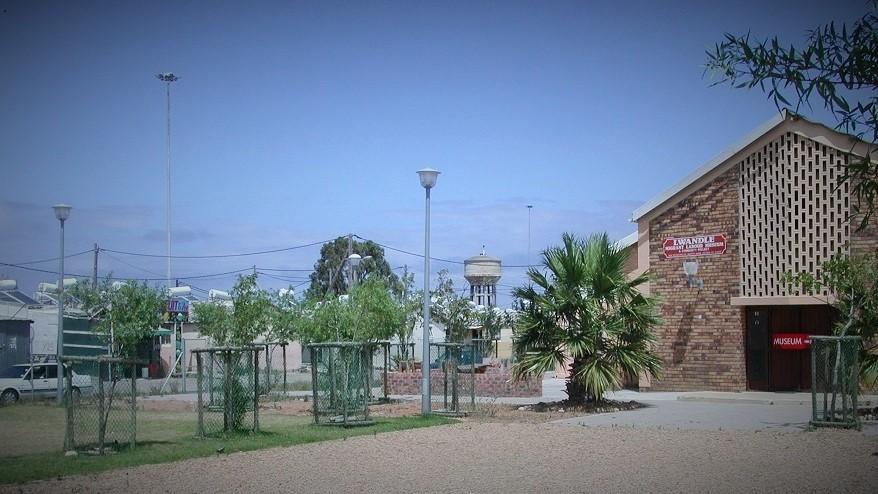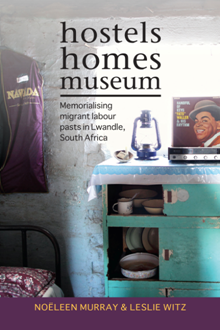
I discovered the existence of the Lwandle Migrant Labour Museum (located in Lwandle, the nearest township to Somerset West and Gordon's Bay) when enjoying a Christmas seaside vacation. Somerset West is worth exploring with many layers of historical experience from the great wine estates of Vergelegen and Lourensford to the remnants of industrial archaeology to be seen at the old Somerset West African Explosives and Chemical Industries estate, from the scenic drive through Gordon's Bay to the unusual workers museum at Lwandle which is the subject of this book. Somerset West is located some 40kms from Cape Town with the Hottentot Holland mountains rising above the town to the east. It is changing rapidly as retirement villages, wine farms, holiday flats, vast shopping malls and smooth motorways make the area a desirable place to live and be a migrant for all income levels.
However, past patterns of spatial segregation persist determined by Income, work and economics. This lovely corner of the Western Cape by the seaside is another of those South African patchwork kind of places where affluence and poverty still rub shoulders.
But it is a place where two strands of history are worth recognizing and celebrating. Right now reclaiming even recent history is important because of the changing contours of settlement. Workers museums are still a rarity and it is unusual to find a museum to migrant labour. The creation of such a novel museum is part of the process of redress, the expression of new forms of oral history and the reshaping of transformational heritage. It is also worth documenting the decisions that led to the establishment of a museum to migrancy and the personal experience of so many black people who flocked from the Eastern Cape to the Western Cape in search of work and a better life. Lwandle was a native location established in the 1950s during the apartheid era when black rural migrants were regarded as temporary city sojourners, but it took on a permanence and a character of its own.
This strongly academic book is a careful study of the making and remaking of this township museum (it was the first of its kind in the Western Cape Province). Committed activists, planners, architects and local community leaders crossed disciplinary boundaries and sought to capture individual and community histories to validate and give worth to the lived working experience and hardships of so many migrants. A significant part of the story has been the project to rehabilitate a migrant labour hostel, Hostel 33. Oral histories and visual displays memorialize migrancy. This study asks what is a museum and how can the traditional boundaries of relegating the past to a museum be rearranged to make a museum a present and relevant institution and an expression of the lived experience, not just for tourists or academics but for the people who still live in Lwandle.
Book Cover
Both the authors, Noeleen Murray (an architect) and Leslie Witz (historian) are academics at the University of the Western Cape and served on the board of the Lwandle Migrant Labour Museum and became intensely involved in hand-on collaboration in the making of the museum. This gives their writing an engaged immediacy and also means that the focus is on an academic account of museum making and it's challenges.
This book is a documentation of the making of a museum and how disciplinary boundaries were dissolved in the making of new histories. Two photographic essays (all these pics are in colour) are attractive features but a photograph needs a label and a date and these are lacking. The small black and white, rather dark photographs do not do justice to the documentary process. This book is likely to appeal to museum practitioners and heritage specialists. It is a guidebook on how to create a new museum and the current debates in the profession. On the other hand if the object is to promote the Lwandle Museum as a tourist attraction and to provide visitors with a souvenir, this book will have only limited appeal.
2017 Price Guide: R255 Available via Juta Online
Main image via Lwandle Museum website. Review copy provided by UCT Press. Review originally published in 2015.
Kathy Munro is an Honorary Associate Professor in the School of Architecture and Planning at the University of the Witwatersrand. She enjoyed a long career as an academic and in management at Wits University. She trained as an economic historian. She is an enthusiastic book person and has built her own somewhat eclectic book collection over 40 years. Her interests cover Africana, Johannesburg history, history, art history, travel, business and banking histories. She researches and writes on historical architecture and heritage matters. She is a member of the Board of the Johannesburg Heritage Foundation and is a docent at the Wits Arts Museum. She is currently working on a couple of projects on Johannesburg architects and is researching South African architects, war cemeteries and memorials. Kathy is a member of the online book community the Library thing and recommends this cataloging website and worldwide network as a book lover's haven

